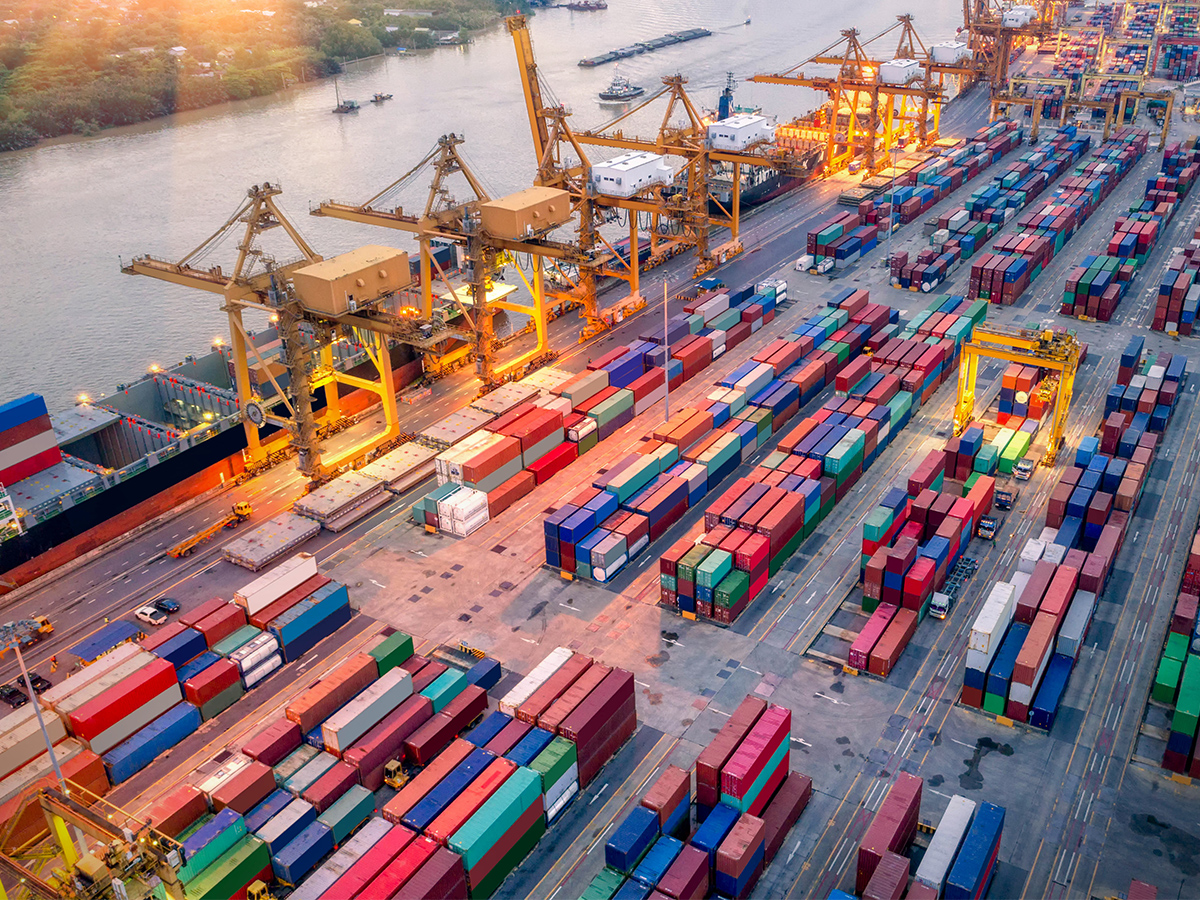Logistics was listed as the #4 issue in the 2021-22 Top Ten Issues Affecting Real Estate® by The Counselors of Real Estate®.
Introduction
Logistics conjures images of the brown UPS delivery vehicle from the 1980s for most baby boomers. For younger generations, though, logistics is an often used—but mostly misunderstood—term that impacts all MSAs and commercial property types from housing to retail stores and warehouses. The term came back into focus during the Trump-era 2019 tariffs that disrupted supply-chains for everything from Canadian lumber and Asian steel to what seemed like all that found its way into a Walmart store; however, logistics is now the item we use to explain COVID-era supply-chain disruption. It is also what the Federal Reserve now blames for “Transitory Inflation.” So, what is this thing we call logistics, and why is it a 2021-22 Top Ten Issue Affecting Real Estate?
Logistics is simply the relay race that materials and goods compete in every day moving across intermodal transportation (land, sea, and air cargo) to the end-user, be it a business (B2B) or consumer (B2C), and commercial real estate is the field on which it all plays out. Whether it’s a port, rail line, pipeline (such as the now infamous Colonial gas pipeline), manufacturing facility, warehouse, farm or ranch (that are increasingly owned institutionally, according to the NCREIF Farmland Index), or grocery store, all these real estate assets are a critical segment in the supply-chain relay race that is logistics.1 How logistics is functioning impacts the utilization of commercial real estate. That is why logistics is a Top Ten Issue.
The Evolving Logistics Model
Modern-day Logistics is rooted in a process developed during WWII to move and supply troops. World War II is the quintessential historical example underscoring the significance of supply chain logistics. In a June CCIM Institute Insights paper titled “Last-Mile Logistics: Commercial Real Estate’s Growth Engine”, I explain that in the 1940s,
“troops and supplies had to move great distances across varied geography at a speed unevenly matched with the infrastructure of the time because there were no interstate highways or container ports like there are today.2 Railroads became the “essential mile” in the supply chain for the war effort, the precursor to today’s “Last-Mile.” Fast forward three quarters of a century, and logistics and supply chain are more global in nature with greater demands on capacity and speed with inadequate infrastructure to reach the all-important Last-Mile. Redundancy and the ability to process disruption are two key elements required to support the fast-moving, high-volume requirements of modern-day logistics in the ‘shop-online-and-deliver-to-me’ era in which we find ourselves.” 2
This reality brings into focus current events such as: i) the President’s plans for a “go-broad” infrastructure bill; ii) the pending mega rail merger between Kansas City Southern and Canadian National that will create the first true Class 1 railroad in North America extending from the deep interior of Canada, down through the center of the United States, and on south to the most vital ports and manufacturing regions in Mexico; iii) the in-process industrial REIT merger between Monmouth MREIC and Sam Zell’s EQC in which he is trading in his office commercial real estate model for a new hybrid-powered industrial real estate model that is going all-in on logistics; and iv) record metrics for industrial real estate, be it new supply, net absorption, CPPI (Commercial Property Price Index), and cap rates.
This new logistics model is displacing the 1980s “Just-In-Time” supply-chain model rooted in tens of thousands of physical retail stores to satisfy a “shop and take home” economy.
And the impact is that the traditional retail big-box store is being replaced with hundreds of millions of square feet of eCommerce warehouses that are following the modern logistics infrastructure. These new eCommerce warehouse big-boxes are being developed in what this economist has coined as the “Golden Triangle.” The impact from this new logistics model means thousands more closed retail stores and thousands of new logistics and eCommerce fulfillment warehouses. Another impact is that the nation’s logistics infrastructure has never been more vital in a post-WWII era. The 2021 American Society of Civil Engineers quadrennial report on our nation’s infrastructure and their Infrastructure Report Card (IRC) highlights this point.3 Only Ports and Rail received an acceptable “B” grade, while 11 of the remaining 15 categories continued to receive a failing “D” grade.
In the aforementioned CCIM Institute Insights paper, it is explained that:
“Not all last-mile logistics pathways or models are created equal. Industrial and e-commerce investment is clustering around a region I have long defined as the ‘Golden Triangle.’ The term describes a geographic region that extends from the pinnacle at the Great Lakes southwest to Texas and the Gulf Coast to form one side or leg of the triangle, and then southeast through Tennessee, Alabama, Georgia, the Carolinas, and Florida to form the other side of the triangle. This region is golden in large part because it: i) encompasses five of the seven Class I railroads; ii) has more ports than any other region of the U.S.; and iii) contains 70% of the American population. In other words, the Golden Triangle is the epicenter of logistics infrastructure and where the dominant e-commerce, package delivery, and retail companies are locating their ‘shop-online-and-deliver-to-me’ logistics operations and warehouses.” 4
Conclusion
The Counselors of Real Estate has identified logistics as a 2021-22 Top Ten Issue Affecting Real Estate because it is at the epicenter of what makes our economy function. Logistics is the relay race that materials and goods compete in every day moving across intermodal transportation to end consumers; and commercial real estate is the field on which it all plays out. Logistics post-COVID-19 will disrupt commercial real estate models for years to come. Most commercial property types will be impacted, be it manufacturing, retail, or eCommerce and warehousing.
Out is the 1980’s “Just-In-Time” logistics supply-chain model. The where and why behind site selection for factories, supply-chain, and eCommerce logistics will be explained by the location of modern logistics infrastructure in which the relay race of materials and goods can operate at faster speed and with more capacity and redundancy without dropping the baton/package. As Walmart defined this new logistics model in 2018, it’s all about OTIF – “On Time and In Full.”
Disruption in commercial real estate capital allocation (more to industrial property category and less to retail) can be expected. There will be less dependency on physical stores and more on modern eCommerce warehouses that will be increasingly automated with less reliance on labor. And expect disruption in pricing as cap rates are going lower for industrial. As the Monmouth MREIC and EQC REIT merger highlights, the 4%-5% Cap Rates once reserved for the Los Angeles/Long Beach and Inland Empire markets now apply to the “Golden Triangle” and secondary MSAs in proximity to the modernized logistics infrastructure. •
Endnotes
1. “NCREIF Farmland Property Index.” National Council of Real Estate Investment Fiduciaries. https://www.ncreif.org/data-products/farmland/ (accessed July 8, 2021). ↩
2. K.C. Conway. “Last-Mile Logistics: Commercial Real Estate’s Growth Engine.” CCIM Institute, June 2021. https://www.ccim.com/newscenter/commercial-real-estate-insights-report/last-mile-logistics–commercial-real-estate-s-growth-engine/ (accessed July 8, 2021). ↩
3. Jay Landers. “ASCE’s 2021 report card marks the nation’s infrastructure progress.” The Civil Engineering Source, American Society of Civil Engineers, March 3, 2021. https://source.asce.org/asces-2021-report-card-marks-the-nations-infrastructure-progress/ (accessed July 8, 2021). ↩
4. Conway, supra note 2. ↩


 Photo: Travel mania/Shutterstock.com
Photo: Travel mania/Shutterstock.com



